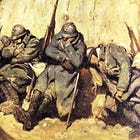Attrition at Verdun (Part V)
The German Army of World War I
The divisions destined to take part in the battle - most of which had been on the Western Front throughout 1915 - approached the operation as they would any other attack “with limited objectives.” Units were pulled out of the trenches, given a few days to rest and then put through training programs that focused on close combat skills. As had often been the case with “state of the art” infantry units in 1915, the training pro- grams often culminated with “dress rehearsals” of company, battalion, regimental, and, in at least one case, division, attacks on full scale replicas of the terrain over which they were scheduled to fight.
The artillerymen, on the other hand, took a very different view. They bragged that their bombardment would be so effective that the German infantry would be able to parade march (“goosestep”) into the citadel of the old fortress complex. The German offensive at Verdun began early on the morning of the 21st of February. At 8:12 a.m. Crown Prince William gave the order for the artillery to open fire. With the exception of a few pauses to allow patrols to ascertain the damage, the bombardment lasted all day.
The patrols usually reported seeing caved-intrenches, destroyed barbed wire obstacles, and groups of French soldiers running to the rear. The patrols also reported that they had received little or no fire from the enemy positions; the only German casualty of the day was an artillery liaison officer hit by a splinter from a short round. In some cases, the patrols even managed to take prisoners. Pilots of reconnaissance aircraft confirmed the reports of widespread destruction. They described railroad tracks that had been torn up by the shells of the German heavy artillery and reported that fires had broken out in the town of Verdun. On the second day, each of the nine infantry divisions of the Fifth Army conducted a series of attacks with limited objectives to capture the forward–most French position in front of its sector. The promise made by German artillery officers that the infantry would be able to “goose step” across “no man’s land,” however, was not fulfilled.
The twenty-four hour bombardment had certainly torn up the ground forward of the German line and caused unprecedented destruction. That same bombardment, how- ever, served also to arouse in the survivors a fanatical spirit of resistance that could only be overcome in close combat. Beginning on the third day of battle, the Beginning on the third day of battle, the German attacks began to acquire characteristics that totally severed the link between Falkenhayn’s intent and the actions of his subordinates. The clearest documentary evidence of this divorce between strategy and tactics is provided by the brief order given by the commanding general of the 6th (Brandenburg) Infantry Division on the 23rd of February. In instructing his three infantry regiments to take the French positions in a woods known as the Herbebois, he admonished them to attack “without regard to casualties.”
Thus died, along with some 300,000 soldiers on either side, Falkenhayn’s vision of a battle in which the killing done by artillery would, in and of itself, convince France to sue for peace.
Sources:
The details of this story come from Volume 10 of Der Weltkrieg, the German official history of the First World War. Bearing the subtitle Die Operationen des Jahres 1916 bis zu Wechsel in der obersten Heeresleitung, this volume was published in 1936.
The material about the clash of visions between Crown Prince Wilhelm and General von Falkenhahyn come from Wilhelm’s memoirs, Meine Erinnerungen aus Deutschlands Heldenkampf (Berlin: E.S. Mittler & Sohn, 1923), pages 159 and 160. (The corresponding pages in the English-language translation published by McBride in 1923 are 165 and 166.)
For the other posts in this series (and several pieces on related themes), see:
To subscribe, support, or share:






We are frequently told that the Germans are the maestros of mission orders and giving scope to subordinates to give affect to the commanders intent. In this case the commanders intent was never communicated at all, or was completely disregarded if it was. The mythical Germans far exceed the capabilities of the actual Germans in using mission orders, at least in this critical battle!
Excellent summary of the issues surrounding the horrific battle of Verdun. Another reader commented that Auftragstaktic was not taken seriously. I would contend that the mission type orders are a tactical measure to carry out the commander’s intent. The Machiavellian politics at the highest command levels can’t be considered a deviation from mission type orders which in my opinion are zenith of professional warfighting at the tactical level. Great Armies are often defeated by the friction between high level senior commanders despite the tactical competence of the units they lead.